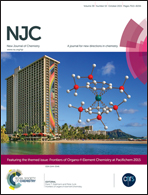A sensitive quenched electrochemiluminescent DNA sensor based on the catalytic activity of gold nanoparticle functionalized MoS2
Abstract
In this paper, molybdenum disulfide (MoS2) was synthesized through the hydrothermal method, which was further fabricated into gold nanoparticle (AuNP) functionalized MoS2 (MoS2–Au). The prepared MoS2–Au showed an excellent catalytic performance of hydrogen peroxide (H2O2) in the reduction reaction. In addition, the CdS/ZnS quantum dots coated with polyethyleneimine (PEI-CdS/ZnS QDs) with good electrochemiluminescence (ECL) properties were prepared. Finally, the prepared MoS2–Au and PEI-CdS/ZnS QDs were applied in a simple sandwich-type ECL sensor for DNA detection. In the DNA sensor, PEI-CdS/ZnS QDs acted as solid supports for capturing DNA and MoS2–Au was employed as the supporter of reporter DNA. MoS2–Au could quench the ECL signal of the PEI-CdS/ZnS QDs in which Au could facilitate the ECL measure and the quenching ECL intensity could be obtained. The proposed DNA sensor enabled target DNA concentrations to be determined in the 0.05–1000 fM concentration range, with a detection limit of 0.023 fM. The DNA sensor showed a low detection limit, good specificity, high sensitivity and reproducibility. Hence, the use of proposed electrochemiluminescent biosensors could become a promising method for DNA detection.



 Please wait while we load your content...
Please wait while we load your content...